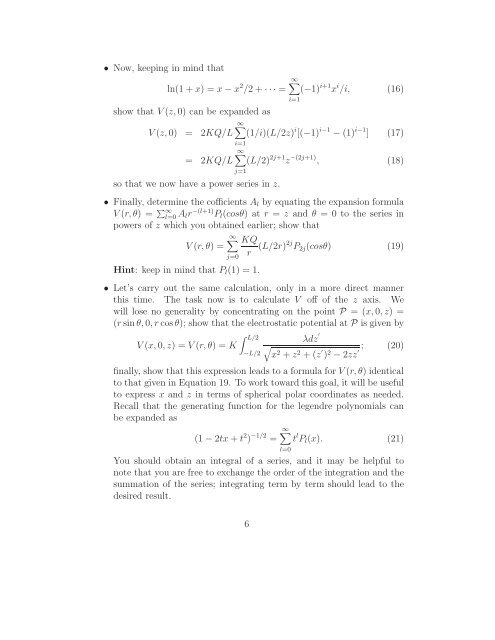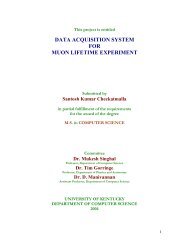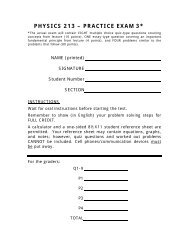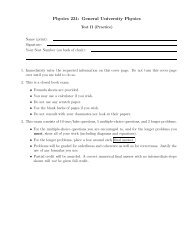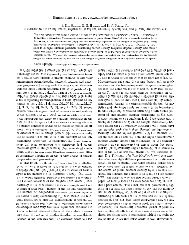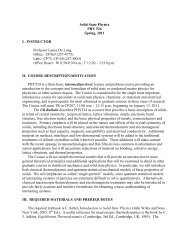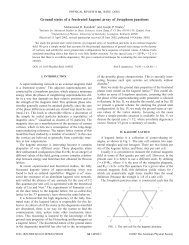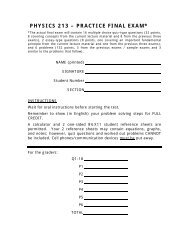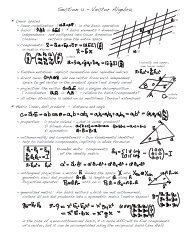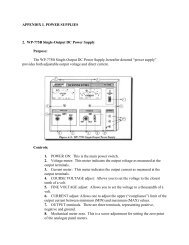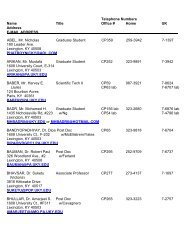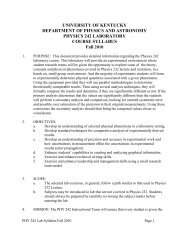Physics 500: Mathematical Methods (first midterm exam)
Physics 500: Mathematical Methods (first midterm exam)
Physics 500: Mathematical Methods (first midterm exam)
Create successful ePaper yourself
Turn your PDF publications into a flip-book with our unique Google optimized e-Paper software.
• Now, keeping in mind that<br />
∞∑<br />
ln(1 + x) = x − x 2 /2 + · · · = (−1) i+1 x i /i, (16)<br />
i=1<br />
show that V (z, 0) can be expanded as<br />
∞∑<br />
V (z, 0) = 2KQ/L (1/i)(L/2z) i [(−1) i−1 − (1) i−1 ] (17)<br />
i=1<br />
∞∑<br />
= 2KQ/L (L/2) 2j+1 z −(2j+1) , (18)<br />
j=1<br />
so that we now have a power series in z.<br />
• Finally, determine the cofficients A l by equating the expansion formula<br />
V (r, θ) = ∑ ∞<br />
l=0 A l r −(l+1) P l (cosθ) at r = z and θ = 0 to the series in<br />
powers of z which you obtained earlier; show that<br />
V (r, θ) =<br />
∞∑<br />
j=0<br />
Hint: keep in mind that P l (1) = 1.<br />
KQ<br />
r (L/2r)2j P 2j (cosθ) (19)<br />
• Let’s carry out the same calculation, only in a more direct manner<br />
this time. The task now is to calculate V off of the z axis. We<br />
will lose no generality by concentrating on the point P = (x, 0, z) =<br />
(r sin θ, 0, r cosθ); show that the electrostatic potential at P is given by<br />
V (x, 0, z) = V (r, θ) = K<br />
∫ L/2<br />
−L/2<br />
λdz ′<br />
√x 2 + z 2 + (z ′ ) 2 − 2zz ′ ; (20)<br />
finally, show that this expression leads to a formula for V (r, θ) identical<br />
to that given in Equation 19. To work toward this goal, it will be useful<br />
to express x and z in terms of spherical polar coordinates as needed.<br />
Recall that the generating function for the legendre polynomials can<br />
be expanded as<br />
∞∑<br />
(1 − 2tx + t 2 ) −1/2 = t l P l (x). (21)<br />
You should obtain an integral of a series, and it may be helpful to<br />
note that you are free to exchange the order of the integration and the<br />
summation of the series; integrating term by term should lead to the<br />
desired result.<br />
l=0<br />
6


